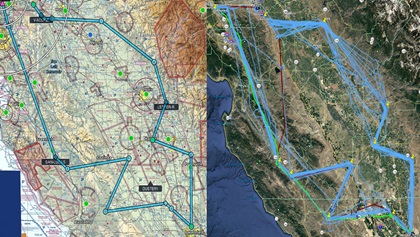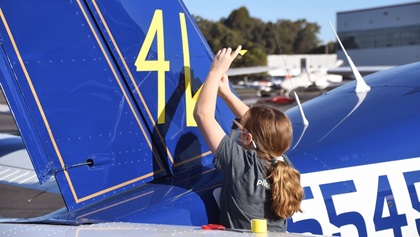Hayward Air Rally beats COVID-19, wildfires
Rescheduled twice, 2020 event flown October 17
With its traditional four-day format shortened because of the coronavirus pandemic to limit the event’s traditional social interaction, the 2020 Hayward Air Rally then had to be postponed for two weeks because of smoke from California wildfires. Finally, the fifty-sixth iteration of what organizers describe as the longest continually held proficiency flying event in the United States was flown October 17 in two legs from Hayward to Tracy, California.
And the pilot who won the rally almost didn’t race. “We made the decision to enter at the last minute,” said Mitzi Saylor of Gilroy, California, who flew with her husband and co-pilot, Dave Saylor. Their Van’s Aircraft RV–10 had been out of service since the beginning of the year for a major avionics upgrade, which had not been completed in time for the original race date in early October. Traditionally held in the spring, this year’s Hayward Air Rally originally was scheduled for October 1 through 4; organizers vowed the rally would persevere through the pandemic—then California experienced unprecedented wildfires.
She decided to register for the rally, which was possible only because of the wildfire postponement. The late entry meant that Millie, their Maltese mix, had to accompany them because Saylor couldn’t arrange care for her at the last minute. “We had arrangements for her the original race weekend.”
The win may have surprised Saylor more than anyone. “We had only gotten the airplane operational like six days before. We had new avionics. My only hope was to be in the top 10,” she said.
But participating was more important to Saylor than winning. “This is my seventeenth time in the last 22 years. I’ve become good friends with a lot of the people there. I really just wanted to see everyone—from a distance—and bump elbows. I almost didn’t believe it when he said our names. It was definitely a nice feeling, and unexpected because of all the adversity we’d been through with the airplane.

“I blew the fuel estimate on the first leg, and I thought that took me out of the running completely. It was a pleasant surprise,” she said. The event is not a race; crews fly against their planned time and fuel consumption. Scoring emphasizes traditional flight planning and pilotage skills, and every second—and fraction of a gallon—higher or lower than planned results in penalty points. As in golf, the lowest number wins. AOPA Pilot’s article about the 2017 rally describes the scoring as well as the detailed planning, narrow margins, and spirited competition involved in the event. “The fires were a big issue around here, even this weekend,” she added. “There was a TFR that was pretty close to one of the checkpoints on the second leg. It was a challenge for a lot of people this year.”
Saylor had never won the rally before. “I’ve been second three times,” she said, including 2018—when her husband, who usually flies as her co-pilot, had his appendix removed two days before the rally. Although he was left in the able care of family members, “I felt terribly guilty about leaving him home.”
The rally course was announced the day before the event. There were two legs of approximately 250 nautical miles each, from Hayward to Bakersfield and from Bakersfield to Tracy. Flight crews had to visually identify multiple checkpoints on each leg. It was the rally’s first use of a one-day, out-and-back event format, and many participants flew home from Tracy once they refueled using calibrated pumps. Overall rally statistics include a total distance flown of 10,824 nautical miles over a total time on the course of 62 hours, 31 minutes; a total of 866.55 gallons of avgas were consumed by the 19 participating aircraft.
Completing the rally feels like a great success in a year that has not had many of those, said Tom Neale, co-chairman of the Hayward Air Rally Committee. “As usual, it was a team effort. A lot of people contributed. It’s an all-volunteer organization and our volunteers really stepped up. Our competitors demonstrated great patience with our two-week delay caused by wildfire smoke and low visibilities.”

Changes to the plan had to be made almost until launch, Neale added: “The wildfires have caused several very large TFRs. Those are a challenge to navigate around and required the very late change-out of a checkpoint and a route change, since I had earlier chosen a checkpoint that was suddenly deep inside a TFR. Flexibility is key, just like in everyday life this year. People and GA are very adaptable; we can make things happen.”
Two Cessna 150s, Race 16 and Race 19, were entered by students from California Aeronautical University in Bakersfield, Neale said, commenting that collegiate entries in the rally are unusual. “It is usually too expensive and time consuming [for college students]. The one-day format and the lower cost seemed to help.” Several volunteers from CAU assisted on the ramp, and with timing at Bakersfield and Wasco. “They were a very active bunch this year.”
Plans for the 2021 rally probably will not be decided for at least another month, he said.
Rally proceeds this year funded scholarships for two young adults to the Experimental Aircraft Association’s Air Academy in Oshkosh, Wisconsin, including full tuition and roundtrip airfare. This year’s recipients are Autumn Legge of Nevada City, California, a senior at Nevada Union High School, and Evan Beach of Santa Rosa, California, a junior at Petaluma High School.
The Hayward Air Rally’s awards were presented online, and several of the pilots stayed on the video call to talk afterward. “We sort of did the hospitality suite thing on the Zoom, and that was kind of nice to be able to do. But it’s not the same,” Saylor said. “If we have to do it that way next year, if I can get the time off, I’ll be back. The whole social aspect of the air rally is still there, and that’s what’s important to me.”




